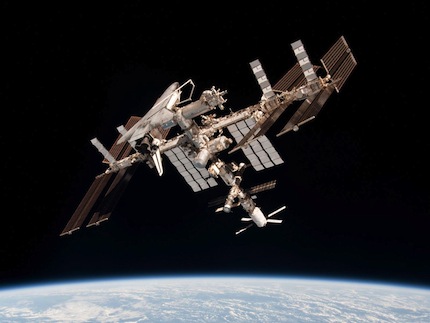STEM | News
YouTube's Space Lab To Blast Teens' Ideas into Space
- By Dian Schaffhauser
- 10/10/11
A consortium of private companies and government space agencies is banding together in a worldwide educational venture being sparked by Google to inspire students to study space. YouTube Space Lab will challenge 14- to 18-year-old students to design a science experiment that can be performed in space. During 2012 two of those experiments will be conducted aboard the International Space Station (ISS) and live streamed on YouTube.
Participants in the program include not just YouTube, but also Lenovo, which currently has dozens of its ThinkPad computers in use on the ISS, and Space Adventures, a private space exploration company that currently takes passengers up on zero-gravity flights. Participating space agencies include the National Aeronautics and Space Administration (NASA), the European Space Agency (ESA), and the Japan Aerospace Exploration Agency (JAXA)
| | 
Winning students will be able to see their experiments carried out on the International Space Station via a live stream on YouTube. | |
For the first step of the competition, students must submit a video no longer than two minutes by December 7, 2011 to YouTube that describes their experiment. Each student can submit videos for up to three proposed experiments. Students can work alone or in groups of two or three. The video can consist of an explanation on a whiteboard or demonstration of a mock-up in the classroom and must include the following components:
- Experiment Question: The scientific question the entrant wants to test;
- Hypothesis: An educated guess at answering the experiment question;
- Method: A simple explanation of the methods used to conduct the experiment testing the hypothesis in microgravity; and
- Results: The expected results of the experiment.
The entries must be in one of two disciplines: biological or the physical sciences. All of those entries, which Google hopes will number in the "thousands," will be whittled down to 60 semi-finalists, 20 from each region of the world, the Americas, Europe, the Middle East, and Africa (EMEA), and Asia-Pacific. The top 60 semi-finalists will be announced on January 3, 2012.
From that set, six finalists from around the world will head to Washington, D.C. for special events, including the opportunity to take a zero-G flight. Each will also receive a Lenovo ideaPad laptop. From those six finalists will be selected the two experiments that will head up to space. As part of their prizes, the students of each winning experiment may choose to watch their experiment from Japan blasting into space bound for the ISS; or, if they've reached the age of 18, they can attend astronaut school in Star City, Russia, where Russian cosmonauts and private space travelers receive training.
Although semi-finalists will be judged by public voting during a single week, submissions will also be evaluated by a team of scientists, astronauts, and educators, including professor Stephen Hawking, NASA's Associate Administrator for Human Exploration and Operations William Gerstenmaier, NASA's Associate Administrator of Education and former Astronaut Leland Melvin, ESA Astronaut Frank De Winne, JAXA Astronaut Akihiko Hoshide, and Cirque du Soleil founder Guy Laliberté.
The finalist projects will be vetted and equipped by scientists at the University of Colorado's BioServe Space Technologies, which conducts experiments in anti-gravity and space hardware design.
One science teacher expressed excitement about the program, even though most of her students are currently too young to enter the competition. "I'm thrilled that my students will now have the opportunity to participate in a global science experiment through Space Lab that will allow them to step outside the classroom and explore the universe beyond our world," said Ellen Bray, a science teacher at middle school, KIPP San Francisco Bay Academy. "With Space Lab, we now have an opportunity to inspire the next generation of space travelers! Who knows? The next Neil Armstrong or Mae C. Jemison might be sitting in my class right now, and Space Lab will get this student one step closer to realizing their dream."
The idea for Space Lab was created by Zahaan Bharmal, head of marketing operations for Google in EMEA. "The Space Lab channel will serve as a home base on YouTube for creating, sharing, and discovering the best space and science-related videos in the world. Our goal is to encourage students to explore the world of science, earthbound and beyond, by first accessing YouTube, and ultimately space," he said.
Bharmal had just joined Google when he pitched the idea for Space Lab to the company during an internal competition that allows staff to put forward new ideas for funding. "Very luckily for me, the folks here liked the idea," he noted. "This idea I pitched is now becoming a reality."
"Working with Space Adventures as part of the Space Lab competition provides a great opportunity for NASA to make space accessible to a wider audience," said Regina Blue, manager of ISS National Laboratory Education Projects at NASA. "The competition gives young people across the globe a chance to get a sense of what it's like to design and build experiments that are suitable for microgravity, and hopefully gives them a taste of what it takes to be a real-world scientist or engineer."
Space Lab is one component of YouTube's broader educational offering at youtube.com/education. Google also offers YouTube.com/Teachers, a site where instructors can learn how to integrate the use of video into their classrooms.
Rules and other details about the competition are posted on a Google site at sites.google.com/site/ytspacelab/.
About the Author
Dian Schaffhauser is a former senior contributing editor for 1105 Media's education publications THE Journal, Campus Technology and Spaces4Learning.